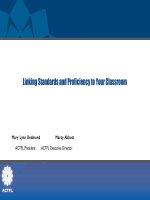LinkingStandardsProftoClassroom ACTFLRegionalSession2014
Bạn đang xem bản rút gọn của tài liệu. Xem và tải ngay bản đầy đủ của tài liệu tại đây (3.33 MB, 63 trang )
Linking Standards and Proficiency to Your Classroom
Mar y Lynn Redmond
ACTFL President
Marty Abbott
ACTFL Executive Director
Today’s Learning Goals
I can …
•
Describe the WHAT, HOW, and HOW WELL to guide my teaching and my students’
learning
•
•
•
Connect key national initiatives to my daily classroom instruction
Identify effective and appropriate means to measure student growth
Describe various components for supporting and evaluating teacher effectiveness
Hello
Unlock the Gateway to Communication
Backward Design
•
•
1. What are the goals? Identify desired results
2. How will you and learners know they reached the
goals? Identify acceptable evidence
•
3. What does it take to get there?
Plan learning experiences
and instruction
Backward Design
•
1. What are the goals? Identify desired results
WHAT
Standards
HOW WELL
Proficiency Levels
Timeline
Standards for Learning Languages
1993 – 1996 Standards developed under Goals 2000 Educate America Act
1996 Publication of Standards for Foreign Language Learning: Preparing for the 21st
Century (with 10 languages)
2000 Publication of Standards for Foreign Language Learning in the 21st Century (with
Chinese)
2006 Publication of Standards for Foreign Language Learning in the 21st Century (with
Arabic)
2013 Refreshed World-Readiness Standards for Learning Languages
Hello
Standards Collaborative Board
(16 national language organizations)
Our “Common Core”:
5 Cs and the 11 descriptive standards
–
–
–
State Standards in over 40 states
Local curricula based on these Standards
Teacher preparation based on these Standards
Process to “refresh” the Standards influenced by 2011 report, A Decade of
Foreign Language Standards: Impact, Influence, and Future Directions
Guiding Principles for “refreshing” standards:
•
•
Maintain the essence of each standard
Clarify the language
FROM:
Interpersonal Communication: Students engage in conversations, provide and obtain information, express
feelings and emotions, and exchange opinions.
TO:
Interpersonal Communication: Learners interact and negotiate meaning in spoken, signed, or written
conversations to share information, reactions, feelings, and opinions
FROM:
Practices of Culture: Students demonstrate an understanding of the relationship between the practices and
perspectives of the culture studied.
TO:
Relating Cultural Practices to Perspectives: Learners use the language to investigate, explain, and reflect on
the relationship between the practices and perspectives of the cultures studied
FROM:
Lifelong Learning: Students show evidence of becoming life-long learners by using the language for personal
enjoyment and enrichment
TO:
Lifelong Learning: Learners set goals and reflect on their progress in using languages for enjoyment,
enrichment, and advancement
Linking Common Core &
World Languages
Reading
----------------------------------
Interpretive
Listening
Interpersonal
Writing
Presentational
-----------------------------
Speaking
and
Listening
Speaking
Proficiency
Levels:
Novice
Intermediate
Advanced
www.actfl.org/commoncore
Language
•
•
•
/>15
Conventions
How language functions
Vocabulary
Performance Points Toward Proficiency
Documenting Student Growth
Describing Performance
Performance
Descriptors
2012
WHAT:
Standards for
Learning Languages
•
•
Five Cs
Three Modes of Communication
HOW WELL:
•
•
2012 Performance Descriptors for Language Learners
Update and revision of 1998 Performance Guidelines for
K-12 Learners
www.actfl.org – Publications – Performance Descriptors
Performance
Three Ranges of Performance:
Novice
Intermediate
Advanced
Three Modes of Communication: Interpersonal, Interpretive, Presentational
ACTFL Proficiency Guidelines
www.actflproficiencyguidelines2012.org
ACTFL Proficiency Guidelines
www.actflproficiencyguidelines2012.org/speaking
Domain
Functions
Examples
•
•
•
•
•
What it describes
Ask formulaic questions
Functions are the global tasks the learner can perform in
Initiate, maintain, and end a conversation
the language
Create with language
Narrate and describe
Make inferences
21
Domain
Functions
Contexts and
Content
Examples
•
•
•
•
•
•
•
•
•
What it describes
Ask formulaic questions
Functions are the global tasks the learner can perform in
Initiate, maintain, and end a conversation
the language
Create with language
Narrate and describe
Make inferences
Oneself
Contexts are situations within which the learner can
One’s immediate environment
function;
General interest
Work-related
Content is the topics which the learner can understand
and discuss
22
Domain
Functions
Contexts and
Content
Text Type
Examples
•
•
•
•
•
•
•
•
•
•
•
•
•
•
•
•
What it describes
Ask formulaic questions
Functions are the global tasks the learner can perform in
Initiate, maintain, and end a conversation
the language
Create with language
Narrate and describe
Make inferences
Oneself
Contexts are situations within which the learner can
One’s immediate environment
function;
General interest
Work-related
Content is the topics which the learner can understand
and discuss
Words
Text type controlled by the learner is that which the
Phrases
learner is able to understand and produce in order to
Sentences
perform the functions of the level
Questions
Strings of sentences
Connected sentences
Paragraphs
23
How / How well able to be understood and to understand
Domain
Language Control
What it answers
What it describes
How accurate is the language learner’s
Describes the level of control the learner has over certain
language?
language features or strategies to produce or understand
language
24
How / How well able to be understood and to understand
Domain
Language Control
What it answers
What it describes
How accurate is the language learner’s
Describes the level of control the learner has over certain
language?
language features or strategies to produce or understand
language
Vocabulary
How extensive and applicable is the language
Describes the parameters of vocabulary used to produce
learner’s vocabulary?
or understand language
25
